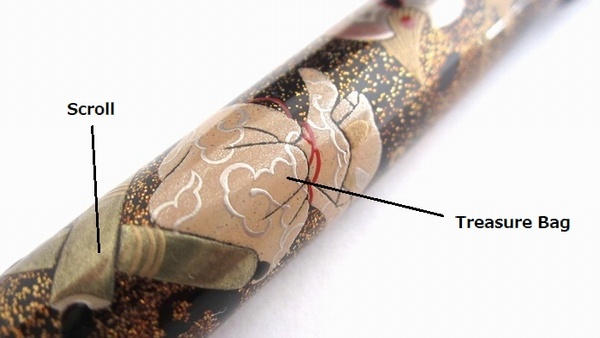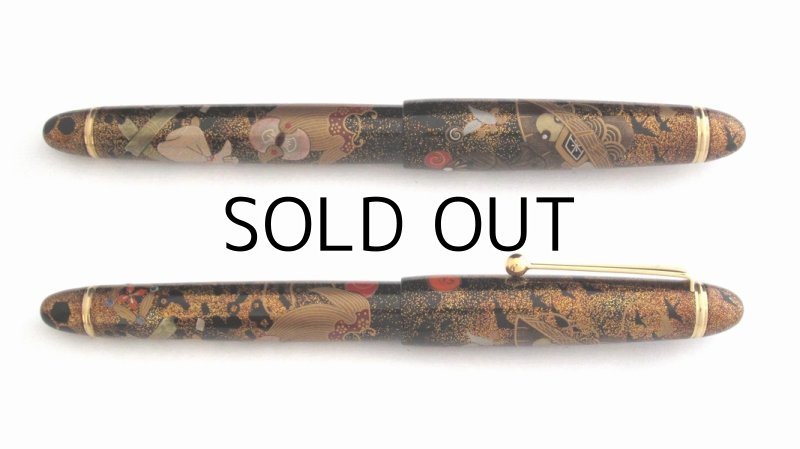AGJ Original Maki-e Fountain pen #25 "Treasures" Sparkling Togidashi Taka Maki-e Kyoto Japan Wa
AGJ Original Maki-e Fountain pen #25 "Treasures" Sparkling Togidashi Taka Maki-e Kyoto Japan Wa
Please contact us from here for the price.
Item Description
This AGJ original Maki-e Fountain pen is made by famous Kyoto Maki-e Artisan "Yuri".
This pen is only one in the world. You can not find it anywhere.
Kyoto Maki-e is the best known Maki-e technique in Japan.
This is original maki-e fountain pen based on a Japanese fountain pen.




The design pattern called "Takara Zukushi", has traditionally used as a motif of good luck and happiness. Japanese people have used the pattern on kimono and tableware for those wishes.
In Edo period (15th century late 17th century), pattern on loincloth for women in samurai family had to be motif of good luck, so loincloths with Takara Zukushi pattern on black cloth were widely used by those women.
The pattern is originated from an idea called "Eight Treasures" of ancient China, and Japanese people started using it in Muromachi period (end of 12th - late 16th century). The eight treasures refer to "conch, wheel, parasol, urn, victory banner, lotus, fish, and endless knot." It also refers to "sword, fish-shaped drum, yin-yang board," "beads, coins, victory," "lock, rhinoceros horn."
Takara Zukushi in Japan generally refers to "wishes, jewel, key, magic mallet, wallet, hide cloak, clove, wreath, and cinerary box." One or combination of few of them is drawn as pattern.


Crane: Hira Maki-e
Silver powders
Lines of Legs and wings of Crane: Gold powders
Red and black urushi are used on the Crane face

Old Weight for a Scale: Hira Maki-e
Mixture of Gold and Silver powders
Circles on the sides: Silver powders
Shade to hide +Strings: Togidashi Taka Maki-e
24K gold powders
Seven treasures: Hira maki-e
The center is the pattern of Silver powders
The circumference is Gold powders

Orb: Hira Maki-e
Gold and Silver powders
Coral: Hira Maki-e
Red Urushi lacquer


Uchide no Kozuchi (Mallet of Luck): Togidashi Taka Maki-e
Grain of woods: Gold powder
Circle on the side: Abalone shell
Grip on the side: Gold powders on black urushi
The front side: Silver patterns on Gold powders

Clove: Hira Maki-e
Gold and Silver powders
Orb: Hira Maki-e
Outline of Orb: Gold powders
Inside: Silver powders and Black Urushi

Orb: Hira Maki-e
Gold powders and red urushi

Cover Coat: Hira Maki-e
Gold powders and Bengara urushi
Old Weight for a Scale: Togidashi Taka Maki-e
24K Gold and Silver powders, and Red/Black Urushi

Scroll: Togidashi Taka Maki-e
Mixture of Gold and Silver powders
Center line: Gold powders
Shaft ends: Black urushi
Scroll edges: Silver powders
Treasure Bag: Hira Maki-e
Silver powders and White Urushi on them
String: Red urushi
Former Japanese oval gold coin (Koban in Japanese)
Round Koban: Gold powders
Rectangular Koban :Silver powders

Seven treasures: Hira Maki-e
Four corners: Abalone shells
Surround: Gold powders
Diamond-shaped flower: Silver powders on red urushi
Center: Gold powders

Scroll: Togidashi Taka Maki-e
Mixture of Gold and Silver powders
Center line: Gold powders
Shaft ends: Black urushi
Scroll edges: Silver powders
Seven treasures: Hira Maki-e
Four corners: Abalone shells
Surround: Gold powders
Diamond-shaped flower: Silver powders on red urushi
Center: Gold powders
[Description]
This pen is only one in the world. You can not find it anywhere.
Kyoto Maki-e is the best known Maki-e technique in Japan.
This is original maki-e fountain pen based on a Japanese fountain pen.




The design pattern called "Takara Zukushi", has traditionally used as a motif of good luck and happiness. Japanese people have used the pattern on kimono and tableware for those wishes.
In Edo period (15th century late 17th century), pattern on loincloth for women in samurai family had to be motif of good luck, so loincloths with Takara Zukushi pattern on black cloth were widely used by those women.
The pattern is originated from an idea called "Eight Treasures" of ancient China, and Japanese people started using it in Muromachi period (end of 12th - late 16th century). The eight treasures refer to "conch, wheel, parasol, urn, victory banner, lotus, fish, and endless knot." It also refers to "sword, fish-shaped drum, yin-yang board," "beads, coins, victory," "lock, rhinoceros horn."
Takara Zukushi in Japan generally refers to "wishes, jewel, key, magic mallet, wallet, hide cloak, clove, wreath, and cinerary box." One or combination of few of them is drawn as pattern.


Crane: Hira Maki-e
Silver powders
Lines of Legs and wings of Crane: Gold powders
Red and black urushi are used on the Crane face

Old Weight for a Scale: Hira Maki-e
Mixture of Gold and Silver powders
Circles on the sides: Silver powders
Shade to hide +Strings: Togidashi Taka Maki-e
24K gold powders
Seven treasures: Hira maki-e
The center is the pattern of Silver powders
The circumference is Gold powders

Orb: Hira Maki-e
Gold and Silver powders
Coral: Hira Maki-e
Red Urushi lacquer


Uchide no Kozuchi (Mallet of Luck): Togidashi Taka Maki-e
Grain of woods: Gold powder
Circle on the side: Abalone shell
Grip on the side: Gold powders on black urushi
The front side: Silver patterns on Gold powders

Clove: Hira Maki-e
Gold and Silver powders
Orb: Hira Maki-e
Outline of Orb: Gold powders
Inside: Silver powders and Black Urushi

Orb: Hira Maki-e
Gold powders and red urushi

Cover Coat: Hira Maki-e
Gold powders and Bengara urushi
Old Weight for a Scale: Togidashi Taka Maki-e
24K Gold and Silver powders, and Red/Black Urushi

Scroll: Togidashi Taka Maki-e
Mixture of Gold and Silver powders
Center line: Gold powders
Shaft ends: Black urushi
Scroll edges: Silver powders
Treasure Bag: Hira Maki-e
Silver powders and White Urushi on them
String: Red urushi
Former Japanese oval gold coin (Koban in Japanese)
Round Koban: Gold powders
Rectangular Koban :Silver powders

Seven treasures: Hira Maki-e
Four corners: Abalone shells
Surround: Gold powders
Diamond-shaped flower: Silver powders on red urushi
Center: Gold powders

Scroll: Togidashi Taka Maki-e
Mixture of Gold and Silver powders
Center line: Gold powders
Shaft ends: Black urushi
Scroll edges: Silver powders
Seven treasures: Hira Maki-e
Four corners: Abalone shells
Surround: Gold powders
Diamond-shaped flower: Silver powders on red urushi
Center: Gold powders
| Name: | Treasures (Takara Zukushi) #25 (Pilot Namiki Original) |
| Maki-e Artist: | Yuri |
| Technique: | Togidashi Taka Maki-e |
| Origin: | Kyoto, Japan |
| Nib: | 14K Gold #15 |
| Nib size: | Medium |
| Size: | 15.7mm(Dia.) x 148mm |
| Shipping: | FREE SHIPPING! |
| Others: | AGJ Original Design Maki-e |
Custom engraving service on AGJ's original Maki-e fountain pens is available for those who wish.
- The lead time: it takes 10-14 days on top (orders without this service will be usually dispatched in 3-5 days after confirming the payment).
- The cost: US$100.00.
- The letters of the name engraved will be engraved in gold just as the signature of the Makie artisans of Original fountain pens.
- Please send us the sample letters which you wish to engrave on the pen (there could be a case where we are unable to engrave the letters of your choice after consulting with the Makie artisans. Letters can be in Japanese Kanji, Katakana and Hiragana but if you choose Kanji, we will use phonetic symbols).
- Please indicate the exact position where you wish to have your name engraved (please understand that there could be a case where we may have to change the position of engraving after consulting with the Makie artisans).
[Yuri's Career]

| Year 1981 | Born in Kyoto |
| 2001 | She followed the family trade of Lacquered tea utensils making and started to work at Studio "Manju" owned by her family. She took charge of design and decoration of Lacquered.work (Maki-e). She also studied the traditional Japanese Painting at Kyoto University of Art and Design. |
| 2009 | The Japanese lacquered tea ware (Usuchaki) made by her won the Kyoto Governor Prize at the 40th Kyo Laquered Ware Exhibition (the prize was won under the Studio's name). Her work was also selected for the 49th Japan Crafts Exhibition. |









